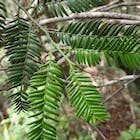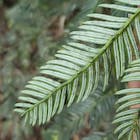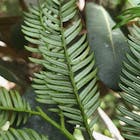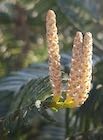Acmopyle pancheri
(Brongniart et Grisebach) Pilger 1926
Common names
New Caledonia acmopyle.
Taxonomic notes
Syn: Dacrydium pancheri Brongniart et Grisebach, Bull. Soc. Bot. France 16 : 330 (1869); Ann. Sci. Nat. Hist. Paris ser. 5, 13 : 346 (1871); Nageia pancheri (Brongniart et Grisebach) Kuntze, Rev. Gen. Pl. 800 (1891); Podocarpus pectinatus Masters, Gard. Chron. Ser. 3, 9 : 113 (1892); Kew Bull.Misc. Inf. : 105 (1892); Hooker, Bot. Mag. 128 : t. 7854 (1902); Acmopyle alba Buchholz, Bull. Mus. Paris ser. 2, 21 : 281 (1949); Sarlin, Bois et Forêts Nouv. Caléd. : 92, tab. 23 (1954); Dallimore et al. (1967).
Cited in Engler, Pflanzenreich 4(5):117 (1903); Sahni, Phil. Trans. Roy. Soc. London, ser. B, 210:262, tab. 10-11 (1920); Dallimore & Jackson, Handbook Conif. : 19 (1923); Pilger, in Engler. Nat. Pflanzenfarm. Ed. 2, 13 : 240 (1926); Florin, K. Svenska Vet. Akad. Handl. 10 : 259 (1931); Palaeontographica 85 (B) : 581 (19444); Sarlin, Bois et Forêt Nouv. Caléd. : 93, tab. 22 (1954); de Laubenfels (1969).
Holotype: Pancher s.n. (1869) (P).
Buchholz describes Acmopyle alba, among other characters, that the pollen cones are larger 18-20 mm long by 3 mm in diameter, in contrast to Acmopyle pancheri 10-20 mm long by 2.3 mm in diameter. The smallest pollen cones were found on Mt. Mou and the largest ones somewhere else. No other differences were observed and therefore Acmopyle alba is no longer considered a separate species (de Laubenfels 1972).
Description
Tree reaching 5-25 m in height. Bark hard, smooth, brownish and fibrous inside, becoming gray with age and scales brake off of old trees. Adult leaves, flattened, bilateral, decurrent, distichuous, linear and spreading away from the branches at a 60-75° angle, having at the beginning 2 glaucuous bands of stomatas on either side of the leaf but disappearing on the upper leaf surface during leaf development, midrib is distinct with a weak line on the upper leaf surface and much more pronounced on the lower leaf surface. The leaves are very short at the beginning with the leafy shoots hardly producing a second cycle of leaves but continue to grow normally on the fertile shoots. Shaded leaves spread themselves out flat, 16-22 mm long by 2.8-3 mm wide, with slightly curved margins. Leaves exposed to the sun are less regular with a well formed carina, often wild and weakly spreading out, 10-15 mm long by 1.8-2.2 mm wide with the occasional intermediate leaf form. The other leaves are reduced to scales, triangular, flat, bifacial, streamlined on the back, 2 mm long, very dense around the base of fertile shoots. Pollen cone terminal, 10-20 mm long by 2.3 mm in diameter, often in pairs, one of the two is lateral, borne on the tip of a leafy shoot or a scaly shoot and accompanied by very small scales at the base. Microsporophylls small and triangular. Seed cone terminal or lateral on the tip of a leafy shoot, on a secondary shoot or a scaly shoot or on all of them at the same time. The seed cone is carried on a peduncle 9-22 mm long densely covered in small scales and formed on a fleshy, verrucose receptacle 8-18 mm long with 4-8 bracts. A single inclined ovule (Mill et al., 2001), projects safely from the epimatium which covers the axil of the bract subapical, becoming erect and fleshy. The epimatium completely melts with the ripe ovule and is attached to it by almost the half of the length and forms a light beard on the ridge of the fruit. Seed globular 10-11 mm in diameter without any fleshy part, thick and hard, distinct with a rough surface and the side joining the epimatium (de Laubenfels 1972).
Distribution and Ecology
New Caledonia (Farjon 1998). Acmopyle pancheri is dispersed in the ombrophilous, humid forests throughout the main island from sea level to 1200 m above sea level (mean elevation 566 m). Within its range, mean annual temperature is 20.0°C, with an average minimum in the coldest month of 13°C, and a mean annual precipitation of 1792 mm (Biffin et al. 2011, Table S5). It is a dominant tree in very wet soils (de Laubenfels 1972). The IUCN reports that the population status is unknown.
This map shows herbarium records of Acmopyle pancheri. Click on an icon for further information. Distribution data from GBIF (2020.03.30), edited to remove duplicates.
Zone 10 (cold hardiness limit between -1°C and +4.4°C) (Bannister and Neuner 2001).
Remarkable Specimens
No data as of 2023.02.21.
Ethnobotany
No data as of 2023.02.21.
Observations
De Laubenfels (1972) reports collections from the following locations:
Mt. Mou, 1100-1200 m
Mt. Koghis, 800-1050 m
Mt. Paéoua, 900-1100 m
Mt. des Sources
Mt. Dzumac pass, 900 m
Mt. Colnett, 1200 m
Mt. Quin
Mt. Koungouhaou, 1000-1100 m
Mt. Boulinda, 1200 m
Mé Arembo
Mois de Mai (type location, Acmopyle alba Buchholz)
Mois de Mai; 200-250m
R. Bleue, 200m
northern slopes of the R. Bleue, 250-770 m
western ridge of the Roussettes pass, 700 m
Bois Électrique, 220m
summit of Diahot, in the Tendé forest, 500 m
summit Kouaoua, NE slopes of Me Ori, 800 m
R. Blanche, 200m.
Remarks
The epithet remembers French botanist Jean A. I. Pancher (1814-1877), who spent much of his working life in New Caledonia; he is also remembered in Callitris pancheri.
Citations
Mill, R.R., M. Möller, S.M. Glidewell, D. Masson, F. Christie, and B. Williamson. 2001. Morphology, anatomy and ontogeny of female cones in Acmopyle pancheri (Brongn. & Grise.) Pilg. (Podocarpaceae). Annals of 88: 55-67.
Thanks to Ferenc Kiss for translating de Laubenfels from the French (2003.04).
See also
Association Endemia, a site devoted to New Caledonian species. Has excellent photos, a range map, and other information. In French.
Lebouvier, N., Lesaffre, L., Hnawia, E., Goué, C., Menut, C. and Nour, M., 2015. Chemical diversity of Podocarpaceae in New Caledonia: Essential oils from leaves of Dacrydium, Falcatifolium, and Acmopyle species. Chemistry & Biodiversity 12(12):1848-1861.
Mill, R., M. Möller, F. Christie, S. Glidewell, D. Masson, and B. Williamson. 2001. Morphology, anatomy and ontogeny of female cones in Acmopyle pancheri (Brongn. & Gris) Pilg. (Podocarpaceae). Annals of Botany 88(1):55–67.
Möller, M., Mill, R. R., Glidewell, S. M., Masson, D., Williamson, B., and Bateman, R. M. 2000. Comparative biology of the pollination mechanisms in Acmopyle pancheri and Phyllocladus hypophyllus (Podocarpaceae sl). Annals of Botany 86(1):149-158.




